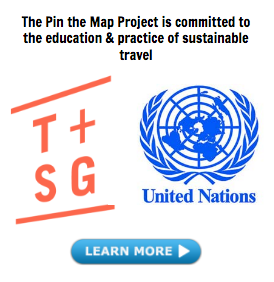
Lest I suffer through yet another biography-length pitch email ending with three attachments and no pitches, I’ve decided to share what makes a good pitch letter. Since assuming the role of Travel Editor at Culture Trip, I have found myself in the rather unprecedented position of being the gate keeper for contributing writers keen on writing for a publication. Sure, I’ve received pitches for The Pin the Map Project, but that gate is typically wide open and easy enough to walk through. A good idea, master of the English language and positive attitude can typically land you a post on this blog (except at the moment, as I am inundated with requests and not accepting submissions).
Culture Trip, on the other hand, is a little different. To give a little behind-the-scenes detail: when I receive a pitch (and I receive a lot) I typically send the ones I am interested in running to my Editor-in-Chief for budget approval. My EIC then ultimately decides the stories that we’ll run on the site and the budget the writer can be paid. Once approved, I’ll work with the writer to edit their draft and get it in ‘tip-top’ shape before sending to my EIC for a final look. The draft gets approved, the story is published, the writer is paid and just like that, we have ourselves a newly minted contributor.
In the past I’ve covered WHAT NOT TO PITCH TRAVEL EDITORS (AS TOLD BY A TRAVEL EDITOR) and A GUIDE TO PITCHING TRAVEL EDITORS (AS TOLD BY A TRAVEL EDITOR), but as it goes it seems that many people - regardless of experience or impressive past bylines - have no idea how to write a pitch letter. Before I launch into it, let me start by saying that some Editors may scoff at the pitch formula I’m about to share, while others may nod in agreement. The days of formulaic pitching as taught to me back in Journalism school, back when dinosaurs roamed the earth, are long gone. People develop their own styles of pitching and what works for them. That said, there are a few pitching no-nos that for your sake (and admittedly the sake of my sanity) I really must share. So here it goes:
1. Make your subject line exciting!
I was joking about this the other day with my boyfriend over yet another Vietnamese dinner (I’m really, quite addicted) that the subject lines for my pitch emails sometimes are so outlandish in attempts to get the Editor’s attention. Look at it this way: an Editor opens their inbox and sees perhaps a hundred or so unopened messages. The Editor will sift through the internal emails from co-workers and their boss and then, start to dive into the pitch emails from interested writers. Hopefully the Editor takes the time to read each pitch vs. shovel them away into a junk folder (if you’re an Editor and don’t read your pitch emails, shame on you). Now of the 20-30 something pitch emails laying in that inbox, which subject line do you think will get a first click:
SUBJECT: Pitch Query
or
SUBJECT: Culture Trip Pitch: Monks in China are Flying! Here’s Why.
2. Now THIS is how you should format a pitch…
So your subject line knocked me off my chair - flying…MONKS?! - so now I’m reading your email. The FIRST few sentences I should read should be about your story. I can’t tell you how many people pitch me and start their emails as a symposium about their life. I’m a world traveler… I’m a famous author … I’m an award winning blogger… I’m a solo traveler extraordinaire…. I just love to travel… Yes, yes I congratulate you on your exemplary experience and die hard love of all things travel. By all means, I do want to hear it, but not right off the bat. Here’s how your pitch email should be structured:
SUBJECT: Pitch: [Insert breathlessly exciting subject line here]
MESSAGE:
Include a paragraph (try not to exceed one paragraph) summarizing your story idea: What is the story? Why does it matter? How will you write it? Who will you interview for it? When will you be able to send it through? (If it’s a trip - when is the travel? If it’s a press trip, make sure to disclose that here)
Next, include a few lines on who you are: Why are you qualified to write this story? Here is where you can include your award winning history, your breath-stealing blog, the time you made a teacher cry from your powerful writing, whatever. Keep it short, sweet and concise. Include A LINK (no attachments) to your published work.
Wrap it up: End with thanking the Editor for their time and consideration.
3. On the topic of published work…
I’ll keep this simple - create an online portfolio, Linkedin page, blog post, something that offers one link click to your published work. Don’t send through multiple links and (unless specifically asked) don’t send through attachments.
4. Please, please, please know the site you’re pitching.
I’ll end with this final piece of advice - one I have all too often ignored myself when freelancing. Your pitch could be wrapped in gold, but it won’t get anywhere if it’s not a fit for the publication you’re pitching. This doesn’t mean visiting BBC Travel, reading three headlines and calling it a day (I’ve tried that - doesn’t work). Nope, this means actually knowing the publication you’re pitching. So here’s my award-winning, take-it-or-leave-it advice: before you pitch a publication spend a few days just reading it. I’m not saying chain yourself to a desk, tape your eyelids open and force feed your brain articles. Rather, read a story a day from that site for maybe a week, just to get an idea of the style of writing they are looking for.
Here’s why it matters…
it is endlessly frustrating for Editors (or perhaps just me) to get email after email from writers who send thoughtful ideas, take the time to reach out and craft a pitch but who clearly haven’t taken the time to read the site. It’s a waste of my time but - more importantly - the writer’s time who is writing the pitch and brainstorming the stories. I do believe all stories have a home. Your narrative article on how Bali changed your life may not be a fit for BBC Travel, but might work for Refinery 29. Your listicle on Bolivia might not work for Culture Trip but it could kill it over at Lonely Planet. Your investigative report on flying monks might not cut it at Matador Network but would flourish at Roads & Kingdoms. You have to know the publications you’re pitching.
So there you have it! The bare bones basics of writing a pitch email. If any questions on pitching, comment below! If you want more posts on improving your travel writing game, make sure to visit my TRAVEL WRITING section.



Annabelle says
Thank you for sharing these tips! They seem very useful!
x Annabelle
travelsandtea.com
Such great tips!
xx Kelly
Sparkles and Shoes
These are great tips, Nikki - thank you! I’ll keep them in mind as I would love to pitch the Culture Trip one day! 🙂 Number 4 is so true, in all aspects of hiring/interviewing! I’m a manager in tourism, and have had countless of applications that just don’t seem to *know* the company (or even the job) they’re applying for! The #1 thing I look for in a candidate is that they genuinely want to work with us, and this is a dead giveaway! 🙂
— Lisa // FjordsandBeaches.com
Yvonne Lynn says
Thanks! Now excuse me while I go change the subject line in that pitch I just wrote. (types frantically)